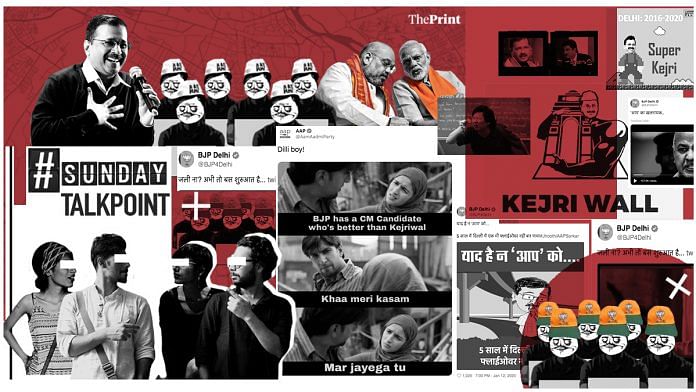The campaigning for Delhi assembly election seems to have become a meme fest between the IT cells of the BJP and AAP. Delhi BJP’s pinned tweet on Saturday was a scathing response to a meme posted by AAP that featured a still from ‘Baazigar’ where Kajol is Delhi, Shah Rukh Khan is AAP’s Arvind Kejriwal and Siddharth Ray is BJP’s Manoj Tiwari.
ThePrint asks: BJP vs AAP memes: Have Delhi elections been reduced to a battle of IT cells?
We remember people who made us laugh, not those who served us well. So, the party with best memes will win Delhi election
 Regina Mihindukulasuriya
Regina Mihindukulasuriya
Senior correspondent, ThePrint
Yes, the political party that posts the best memes on social media will win the upcoming Delhi assembly election.
Memes look innocuous, but they are powerful imagery that use humour to make people remember them. Netizens share them because they like spreading laughter. Memes are the single most effective medium for spreading political propaganda.
And let’s face it, a party wins an election not because it served people well but because it mounted a smart propaganda campaign. This answers why Narendra Modi got elected for a second term and how Donald Trump became the US president. Add to it the fact that the human brain is wired to register people who made us laugh, not those who served us well.
The AAP team is not having a difficult time campaigning for the election because the reigning champion of political memes (the BJP team) is in self-destructive mode — remember that embarrassing gaffe to get more people to give a missed call on a number to show support for the CAA and the other silly gimmick of Hindutva supporters tweeting the same cancelled movie ticket of the Deepika Padukone-starrer Chhapaak?
Yes, AAP is winning this round.
Oh, and a fun fact — the actual pioneer of using memes on social media is the AAP, not the BJP. A prominent BJP social media volunteer has said that he got the idea for satire and memes from how AAP used such content in 2013.
BJP and AAP are using memes to manipulate people on social media, but real war is being fought on the ground
 Tarun Krishna
Tarun Krishna
Correspondent, ThePrint
It won’t be fair to say that the Delhi assembly election has been reduced to a battle of IT cells because all the three major political parties — the BJP, the Congress and the AAP — have been busy campaigning on the streets. The different mediums of communication have been TV, radio, newspaper ads, hoardings and posters. Press conferences have also been held regularly. People in Delhi must have seen those “I love Kejriwal” and “Dilli chale Modi ke saath” posters on autos.
The AAP recently concluded its door-to-door campaign and claimed that it was able to reach out to lakhs of people. The BJP claims that it got more than 11 lakh suggestions for its manifesto through its “Meri Dilli Mera Sujhav” campaign.
At a time when 68 per cent of Indian users are consuming news on their smartphones, memes have become powerful political weapons. But such strategies have been used since the time of the so-called Jan Lokpal Movement in 2011, during which people were manipulated into using the Indian national flag as their display pictures. When you go through the social media handles of the AAP and the BJP, you will find a mix of memes and election-related posts.
The IT cells of both the AAP and the BJP are using memes to deliver their messages and set a counter-narrative against each other. But the real war is being fought on the ground.
Seeing Delhi assembly election purely from the lens of a meme fest or a social media war can be slightly rash
 Aneesha Bedi
Aneesha Bedi
Special correspondent, ThePrint
With the Delhi assembly election just a few weeks away, the Aam Aadmi Party has been creating a storm on the internet with its social media posts mocking the opposition. While the BJP is trying to be equally witty, given its experience of social media marketing during elections, the AAP seems to have stayed ahead of the game. Memes, video games and advertisements — be it “Kejri-wall” or a Baazigar meme or Kejriwal as the new Mario in the Japanese video game — have all created a buzz among the Twitterati, including the millennial voters.
Having said that, the Delhi assembly poll is much bigger than a battle of IT cells. However, it is also true that electoral campaigns on social media attract greater attention because people in Delhi are increasingly using the internet. Be it the BJP’s “PAAP ki Adalat” video or AAP’s “#KejriwalvsWho” campaign, these social media tactics are part of a larger political campaign that is being carried out through different modes of communication.
Seeing the Delhi assembly election purely from the lens of a meme fest or a social media war can be slightly rash. Given that the Arvind Kejriwal-led AAP government claims to work on a limited budget, the party has justified that social media becomes an obvious primary communication tool for its leaders to convey their messages.
AAP has upped its social media game, but Kejriwal won’t let it hamper his image of a ‘salt-of-the-earth’ politician
 Soniya Agarwal
Soniya Agarwal
Video journalist, ThePrint
It would be foolish to think that social media campaigning is not important for the AAP and the BJP. Social media is the best medium for reaching out to the youth, including the first-time voters. Political parties adopt different strategies, so they don’t allot the same amount of funds to their IT teams. With leaders of all the three main political parties present on Twitter, the battle of words is fought not only in rallies but are also on social media.
Although the Bharatiya Janata Party is the political outfit with the largest number of online followers, including the trolls, one must not forget that it is also the most ‘traditional’ party in India because of its core philosophy of a ‘Hindu Rashtra‘. Meanwhile, the AAP may have upped its social media game with new memes and videos, but Arvind Kejriwal will never trade it with his image of a ‘salt-of-the-earth’ politician.
So, social media may be a potent tool for political leaders, but it is not a decisive factor in determining election results. For political parties, the public image and the physical presence of a leader still matters and the Delhi assembly election will still be fought in the suburbs of Delhi, with mics and powerful speeches, in large grounds filled with cheering crowds.
Delhi election hasn’t become a meme fest. Parties are still campaigning in traditional ways: rallies, roadshows
 Urjita Bhardwaj
Urjita Bhardwaj
Journalist, ThePrint
No, the Delhi assembly election has not entirely been reduced to a battle of IT cells.
Although it is true that social media is being used as a tool to spread propaganda by both the AAP and the BJP, it is still only one part of the entire campaign process.
Let us not forget that this battle of posting memes is a small one that is being fought in a virtual space. The larger campaign is still being carried out in the traditional way, which includes door-to-door campaigns, rallies and roadshows.
Campaigning for elections is a herculean task, which not only requires a lot of resources in terms of money and manpower but also sharing of novel ideas that will grab the attention of the masses.
The videos on social media — such as the spoof of the Boman Irani Ambuja Cement advertisement created by the AAP and the Congress or a video tweeted by the AAP showing Manoj Tiwari dancing on “#LageRahoKejriwal” — are examples of political mudslinging.
While some are genuinely hilarious, others are in bad taste.
Also read: A toned-down Kejriwal or aggressive Modi-Shah: who has wider appeal in Delhi elections?
By Pia Krishnankutty, journalist at ThePrint







Kaam bolta hai. That is how it should be in a mature democracy.